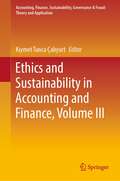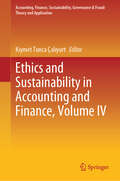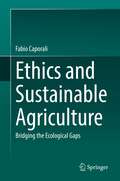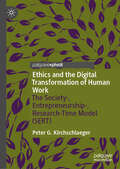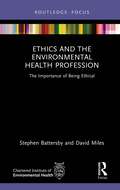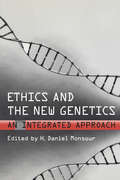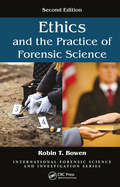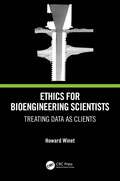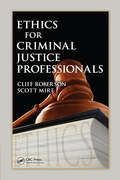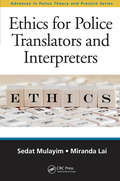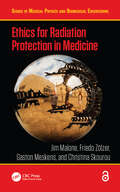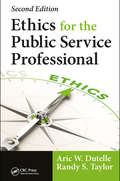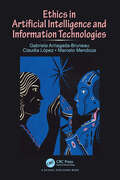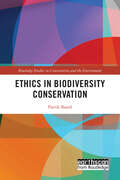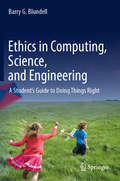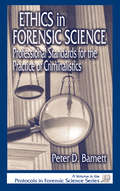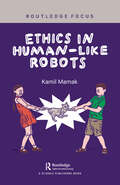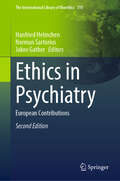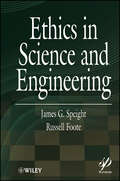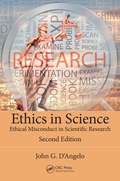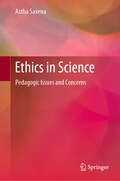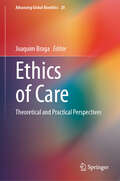- Table View
- List View
Ethics and Sustainability in Accounting and Finance, Volume III (Accounting, Finance, Sustainability, Governance & Fraud: Theory and Application)
by Kıymet Tunca ÇalıyurtThis book continues the discussion on recent developments relating to ethical and sustainable issues in accounting and finance from the book , Volumes I and II, looking into topics such as the importance of good governance in accounting, tax, auditing and fraud examination, ethics, sustainability, environmental issues and new technologies and their effects on accounting and finance, focusing in particular on environmental and sustainability reporting in the oil and gas and banking sectors. The book also considers the growing importance of audit quality in this time of the COVID-19 pandemic.
Ethics and Sustainability in Accounting and Finance, Volume IV (Accounting, Finance, Sustainability, Governance & Fraud: Theory and Application)
by Kıymet Tunca ÇalıyurtThis book continues the discussion on recent developments relating to ethical and sustainable issues in accounting and finance from Volumes I to III, looking into topics such as the importance of good governance in accounting, tax, auditing and fraud examination, ethics, sustainability, environmental issues, and new technologies and their effects on accounting and finance, focusing in particular on environmental and sustainability reporting in the oil and gas and banking sectors.
Ethics and Sustainable Agriculture: Bridging the Ecological Gaps
by Fabio CaporaliThis book describes the alarming condition of agriculture in the Anthropocene, when the ethical conception of agriculture as a service of common utility for both society and environment has progressively been marginalized. The ethical utility of agriculture has been sidetracked with the increasing industrialisation of society, the involvement of agriculture in the business-as-usual economy, and the consequential environmental and societal impacts it has had. Thus, re-establishing a meaningful bridge between ethics and agriculture is necessary. A relatively new science (ecology) with both a new epistemological tool (that of the ecosystem concept), and a unique narrative of sustainable development, can help bridge this gap. This book focuses on ethics as a lever for raising scientific, technical, social, economic and political solutions to adopt in agriculture as a model of symbiotic relationships between man and nature. It provides a detailed discussion of the ecological intensification practices in order to maximize ecological and ethical services, wherein agroecosystems will follow.
Ethics and the Digital Transformation of Human Work: The Society-, Entrepreneurship-, Research-Time Model (SERT)
by Peter G. KirchschlaegerDigital transformation and &“AI&”— more adequately defined as &“Data-Based Systems DS&”— will create new jobs and lead to disruptions. Will digital transformation and Data-Based Systems DS lead to a massive reduction of paid professional tasks for humans? This book offers a critical and comprehensive discussion of the impact of digital transformation on human jobs from an ethical perspective. It presents an ethically sound and concrete model to address this pressing issue for societies worldwide: the Society-, Entrepreneurship-, Research-Time-Model (SERT).
Ethics and the Environmental Health Profession: The Importance of Being Ethical (Routledge Focus on Environmental Health)
by Stephen Battersby David MilesProviding an exploration of the discussion on how a stronger ethical basis for the work of environmental health practitioners (EHPs) can contribute to improved public health, because EHPs/environmental health officers (EHOs) come into daily contact with members of the public to address threats to their health and wellbeing. This book examines what is meant by professional ethics and the role of professional bodies in ensuring members of the profession act ethically. They should be expected to act as guardians of the public interest, without fear or favour. Ethics is an integral part of public health decision-making and needs to be incorporated into public and environmental health policy development and decision-making. This work, while seeking to stimulate debate within the environmental health profession, will examine what this means for EHPs.Ethics and the Environmental Health Profession: The Importance of Being Ethical explores the process of ethical decision-making in the environmental health profession and asks the question of whom EHPs have an ethical duty towards in their work. It looks at a variety of ethical issues which arise for EHPs working in local government, as consultants or for commercial companies.This book is useful for EHPs globally, other local government officers, educational establishments where environmental and public health courses are run globally, elected members of local authorities, and policymakers at national and local government levels.
Ethics and the New Genetics: An Integrated Approach (Lonergan Studies)
by H. Daniel MonsourEveryday, new advances are being made in the science of human genetics. Accompanying progress in this area, however, are new ethical dilemmas. At a think tank sponsored by the Canadian Catholic Bioethics Institute, an interdisciplinary group of ethicists, geneticists, physicians, lawyers, and theologians gathered in an attempt to apply some features of Bernard Lonergan's notion of functional specialization to ethical debates surrounding genetics. Editor H. Daniel Monsour has brought together a series of articles presented at this think tank. The articles accomplish two tasks: first, they explore some of the advances in human genetic that continue to prompt ethical debate and outline the different stances on those issues; second, they examine those stances in the context of Roman Catholic moral and religious thought. Timely, innovative, and wide-ranging, this collection will be of interest to bioethicists and philosophers, as well as religious and Lonerganian scholars.
Ethics and the Practice of Forensic Science (International Forensic Science and Investigation)
by Robin T. BowenWhile one would hope that forensic scientists, investigators, and experts are intrinsically ethical by nature, the reality is that these individuals have morality as varied as the general population. These professionals confront ethical dilemmas every day, some with clear-cut protocols and others that frequently have no definitive answers. Since the publication of the first edition of Ethics and the Practice of Forensic Science, the field of forensic science has continued to see its share of controversy. This runs the gamut of news stories from investigators, lab personnel, or even lab directors falsifying results, committing perjury, admitting to fraud, to overturned convictions, questions about bias, ethics, and what constitutes an "expert" on the witness stand. This fully updated edition tackles all these issues—including some specific instances and cases of unethical behavior—and addresses such salient issues as accreditation requirements, standardization of ethical codes, examiner certification, and standards for education and training. The new edition provides: A new chapter on the "Ferguson Effect" faced by the criminal justice system The context of forensic science ethics in relation to general scientific ethics, measurement uncertainty, and ethics in criminal justice Ethical conundrums and real-world examples that forensic scientists confront every day The ethics and conduct codes of 20 different forensic and scientific professional organizations An outline of the National Academies of Science (NAS) recommendations and progress made on ethics in forensic science since the release of the NAS report Ethics and the Practice of Forensic Science, Second Edition explores the range of ethical issues facing those who work in the forensic sciences—highlights the complicated nature of ethics and decision-making at the crime scene, in the lab, and in the courts. The book serves both as an essential resource for laboratories to train their employees and as an invaluable textbook for the growing number of courses on ethics in criminal justice and forensic science curricula. Accompanying PowerPoint® slides and an Instructor’s Manual with Test Bank are available to professors upon qualifying course adoption.
Ethics and the Practice of Forensic Science (International Forensic Science and Investigation)
by Robin T. BowenIntegrity and honesty are the hallmarks of science - and especially so in the case of forensic science - making the study and practice of ethics essential to the field. Ethics and the Practice of Forensic Science, Third Edition directly addresses common stressors that can induce, or lead professionals - working in forensic laboratories, law enforcement, the judicial system, and at crime scenes - to commit misconduct.While forensic scientists, investigators, and experts are intrinsically ethical by nature, the reality is that these individuals face challenges including departmental or political pressures, lack of training, and conflicting standards. The difference, however, is that the work done by forensic professionals has the ability to compromise another person’s freedom, potentially leading to arrest, incarceration, and miscarriages of justice. Police and forensic professionals confront ethical dilemmas every day, some situations that fall within clear protocols or standards and others that frequently have no definitive answers.Ethics and the Practice of Forensic Science, Third Edition includes updated information and case studies, as well as recent research findings focused on ethics in forensic science. Chapters examine investigation and police culture through the lens of professional challenges, incorporating important information about the history of wrongful convictions, and including recent developments in overturned wrongful convictions, and the work of various innocence projects. Throughout the book, case examples of bias, ethical violations, and instances of tampering with evidence present the dangers of compromising one’s ethical standards. Through such cases, the book sheds light on the problem and offers alternative courses of action - presenting examples of what to do, and what not to do, when faced with ethical decisions in gathering, handling, analyzing, and presenting evidence.
Ethics for Bioengineering Scientists: Treating Data as Clients
by Howard WinetThis book introduces bioengineers and students who must generate and/or report scientific data to the ethical challenges they will face in preserving the integrity of their data. It provides the perspective of reaching ethical decisions via pathways that treat data as clients, to whom bioengineering scientists owe a responsibility that is an existential component of their professional identity. The initial chapters lay a historical, biological and philosophical foundation for ethics as a human activity, and data as a foundation of science. The middle chapters explore ethical challenges in lay, engineering, medical and bioengineering scientist settings. These chapters focus on microethics (individual behavior) and cases that showcase the consequences of violating data integrity. Macroethics (policy) is dealt with in the Enrichment sections at the end of the chapters, with essay problems and subjects for debates (in a classroom setting). The book can be used for individual study, using links in the Enrichment sections to access cases and media presentations like PBS’ "Ethics in America". The final chapters explore the impact of bioengineering science ethics on patients via medical product development, its regulation by the FDA, and the contribution of data integrity violation to product failure. The book was developed for advanced undergraduate and graduate students in bioengineering. It also contains much needed material that researchers and academics would find valuable (e.g., FDA survey and lab animal research justification). This book Introduces an approach to ethical decision-making based on treating data as clients Compares the ethics of three professions; engineering, medicine, and bioengineering Provides five moral theories to choose from for evaluating ethical decisions, and includes a procedure for applying them to moral analysis, and application of the procedure to example cases Examines core concepts, like autonomy, confidentiality, conflict of interest, and justice Explains the process of developing a medical product under FDA regulation Explores the role of lawyers and the judiciary in product development, including intellectual property protection Examines a range of ethical cases, from the historical Tuskegee autonomy case to the modern CRISPR-Cas9 patent case. Howard Winet, PhD is an Adjunct Professor recall, Orthopaedic Surgery and Bioengineering at University of California, Los Angeles.
Ethics for Criminal Justice Professionals
by Cliff Roberson Scott MireIncreasing concerns about the accountability of criminal justice professionals at all levels has placed a heightened focus on the behavior of those who work in the system. Judges, attorneys, police, and prison employees are all under increased scrutiny from the public and the media. Ethics for Criminal Justice Professionals examines the myriad of e
Ethics for Engineers: Toward Ethical Behavior within Engineering Organizations (What Every Engineer Should Know)
by Seppo J. Ovaska Andrew T. BreiEthics for Engineers: Toward Ethical Behavior within Engineering Organizations offers a multilevel perspective on engineering ethics with considerable breadth and depth, making it a valuable resource for students, educators, and professionals alike.This pragmatic book contains case studies of micro-level ethical violations, evaluating their moral implications and discussing moral self-licensing behind making unethical decisions. It also explores macro-level cases that have caused significant reputational and financial damage to major companies. In addition, the authors touch on topics whose overall impact is not yet fully understood, such as environmental ethics issues related to wind turbine blades and space debris management. By presenting examples from different levels and offering reflections from various perspectives, this text prompts readers to critically evaluate the ethical implications of their actions and understand what may drive a work community to behave unethically.Key features: Covers both moral theoretical and behavioral ethics perspectives. Contains day-to-day micro-level cases from the lives of practicing engineers, supplemented with macro-level cases. Provides pragmatic guidance for individual engineers and their organizations to move toward value-based ethics. Features colloquial language to make the book an enjoyable and accessible read. Includes 29 demonstrative vignettes, 87 class exercises, and an insightful interview with an ethics ambassador. This unique text serves as a pedagogically sound learning companion for courses in engineering ethics and related topics, striking a balance between research-based findings (with over 40 scholarly references) and real-world experiences (featuring an Appendix by an industry executive).
Ethics for People Who Work in Tech
by Marc SteenThis book is for people who work in the tech industry—computer and data scientists, software developers and engineers, designers, and people in business, marketing or management roles. It is also for people who are involved in the procurement and deployment of advanced applications, algorithms, and AI systems, and in policy making. Together, they create the digital products, services, and systems that shape our societies and daily lives. The book’s aim is to empower people to take responsibility, to ‘upgrade’ their skills for ethical reflection, inquiry, and deliberation. It introduces ethics in an accessible manner with practical examples, outlines of different ethical traditions, and practice-oriented methods. Additional online resources are available at: ethicsforpeoplewhoworkintech.com.
Ethics for Police Translators and Interpreters (Advances in Police Theory and Practice)
by Sedat Mulayim Miranda LaiThis book examines the major theoretical foundations of ethics, before zooming in on definitions of professional practice and applied professional ethics, as distinct from private morals, in general and then focusing on professional ethics for translators and interpreters in police and legal settings. The book concludes with a chapter that offers a model for ethical decision making in the profession.
Ethics for Radiation Protection in Medicine (Series in Medical Physics and Biomedical Engineering)
by Friedo Zölzer Gaston Meskens Jim Malone Christina SkourouThis book presents an up to date ethical framework for radiological protection in medicine. It is consistent with the requirements of the system of radiation protection and with the expectations of medical ethics. It presents an approach rooted in the medical tradition, and alert to contemporary social expectations. It provides readers with a practical framework against which they can assess the safety and acceptability of medical procedures, including patients’ concerns. It will be an invaluable reference for radiologists, radiation oncologists, regulators, medical physicists, technologists, other practitioners, as well as academics, researchers and students of radiation protection in medicine. Features: An authoritative and accessible guide, authored by a team who have contributed to defining the area internationally Includes numerous practical examples/clinical scenarios that illustrate the approach, presenting a pragmatic approach, rather than dwelling on philosophical theories Informed by the latest developments in the thinking of international organizations
Ethics for the Public Service Professional
by Aric W. Dutelle Randy S. TaylorHeadlines of public service corruption scandals are painful reminders of the need for continuing education in the subjects of ethics and integrity. Public service professionals employed as government officials, forensic scientists, investigators, first responders, and those within the legal and justice systems, face daily decisions that can mean the difference between life or death and freedom or imprisonment. Sometimes, such decisions can present ethical dilemmas even to the most seasoned of professionals. Building on the success of the first edition, Ethics for the Public Service Professional, Second Edition serves as a single-source resource for the topic of ethics and ethical decision making as it relates to government service. While incorporating an examination of the history of ethics, codes and legislation, the book exposes the reader to the challenges faced by today’s public service professionals and administrators in incorporating ethics within daily decisions, procedures, and duties. Key features include: Current controversies in police, forensic, and other public service sectors including: racial profiling, evidence tampering, disaster response, and audits Important new mechanisms of accountability, including use-of-force reporting, citizen complaint procedures, and open government Contemporary news stories throughout the book introduce the reader to a broad range of ethical issues facing leaders within the public service workplace Chapter pedagogy including key terms, learning objectives, end-of-chapter questions, a variety of boxed ethical case examples, and references Ripped from the Headlines current event examples demonstrate actual scenarios involving the issues discussed within each chapter This in-depth text will be essential for the foundational development and explanation of protocols used within a successful organization. As such, Ethics for the Public Service Professional, Second Edition will help introduce ethics and ethical decision-making to both those new to the realm of forensic science, criminal justice, and emergency services and those already working in the field.
Ethics in Artificial Intelligence and Information Technologies
by Marcelo Mendoza Gabriela Arriagada-Bruneau Claudia LópezThis book addresses the challenges posed by adopting and developing new AI technologies and how they impact people. Ethics, the scope, and the impact of technology on people are vital. The book starts with the ethical aspects of AI, presenting a socio-technical approach to integrating Ethics into AI projects, and outlines perspectives around feminism, sustainability, and labor transformation. Next, the concepts of fairness, accountability, and transparency are introduced, discussing their implications for developing information systems such as recommender systems, including aspects related to data privacy. Then the book covers the relevance of natural language processing systems, highlighting debias strategies and evaluation methodologies. The scopes of fairness-based approaches for ChatGPT and other generative text models are also introduced. Finally, advanced topics that include the relationship between AI and disinformation are addressed, including a discussion of the scope of news-generative models such as deep fakes. The book ends with a discussion of the perspectives and challenges in the area.The book is meant for an audience of advanced undergraduate and graduate students from all disciplines related to information systems. It is also helpful for researchers and practitioners interested in the subject.
Ethics in Biodiversity Conservation (Routledge Studies in Conservation and the Environment)
by Patrik BaardThis book examines the role of ethics and philosophy in biodiversity conservation. The objective of this book is two-fold: on the one hand it offers a detailed and systematic account of central normative concepts often used, but rarely explicated nor justified, within conservation biology. Such concepts include ‘values’ (both intrinsic, instrumental, and, more recently, relational), ‘rights’, and ‘duties’. The second objective is to emphasize to environmental philosophers and applied ethicists the many interesting decision-making challenges of biodiversity conservation. The book argues that a nuanced account of instrumental values provides a powerful tool for reasoning about the values of biodiversity. It also scrutinizes relational values, the concept of rights of nature, and risk, and show how moral philosophy proves indispensable for these concepts. Consequently, it engages with recent suggestions on normative aspects of biodiversity conservation, and show the need for moral philosophy in biodiversity conservation. The overriding aim of this book is to provide conservation biologists and policy-makers with a systematic overview of concepts and assessments of the reasons for reaching prescriptive conclusions about biodiversity conservation. This will prove instrumental in clarifying the role of applied ethics and a refined understanding of the tools it can provide. This title will be of interest to students and scholars of conservation biology, conservation policy, environmental ethics and environmental philosophy.
Ethics in Computing, Science, and Engineering: A Student’s Guide to Doing Things Right
by Barry G. BlundellThis comprehensive textbook introduces students to the wide-ranging responsibilities of computing, science and engineering professionals by laying strong transdisciplinary foundations and by highlighting ethical issues that may arise during their careers. The work is well illustrated, and makes extensive use of both activities, and ethical dilemmas which are designed to stimulate reader engagement. A number of memorable case studies are also included and frequently draw on the demanding aerospace industry. The book adopts a strongly human centric approach, with matters such as privacy erosion and censorship being viewed not only in their current context but also in terms of their ongoing evolution. What are our individual ethical responsibilities for ensuring that we do not develop for future generations a technological leviathan with the potential to create a dystopian world? A broad range of technologies and techniques are introduced and are examined within an ethical framework. These include biometrics, surveillance systems (including facial recognition), radio frequency identification devices, drone technologies, the Internet of Things, and robotic systems. The application and potential societal ramifications of such systems are examined in some detail and this is intended to support the reader in gaining a clear insight into our current direction of travel. Importantly, the author asks whether we can afford to allow ongoing developments to be primarily driven by market forces, or whether a more cautious approach is needed. Further chapters examine the benefits that are associated with ethical leadership, environmental issues relating to the technology product lifecycle (from inception to e-waste), ethical considerations in research (including medical experimentation involving both humans and animals), and the need to develop educational programs which will better prepare students for the needs of a much more fluid employment landscape. The final chapter introduces a structured approach to ethical issue resolution, providing a valuable, long-term source of reference. In addition it emphasises the ethical responsibilities of the professional, and considers issues that can arise when we endeavour to effect ethically sound change within organisations. Examples are provided which highlight the possible ramifications of exercising ethical valour. The author has thus created an extensively referenced textbook that catalyses student interest, is internationally relevant, and which is multicultural in both its scope and outlook.
Ethics in Forensic Science: Professional Standards for the Practice of Criminalistics (Protocols in Forensic Science)
by Peter D. BarnettWith the complexity of the interactions between the methodology of science, the principles of justice, and the realities of the practice of law and criminalistics, ethical issues frequently arise. One of the hallmarks of a profession is a code of ethics to govern the actions of members of the profession with one another, with users of the professio
Ethics in Human-like Robots
by Kamil MamakThe idea of creating artificial humans can be found at the beginning of the human culture. Ancient myths contain the stories of artificial humans brought to life by gods. The word robot originates from a play that was about artificial humans made from artificial flesh that aims to serve real humans. With advancements in robotics, the materialization of this idea is more real than ever before. We are witnessing attempts to create humanoid robots that might be deployed in many spheres of our life - policing, healthcare, and even for love and sex.The book focuses on the ethical issues of human likeness of robots and human tendency to anthropomorphize. It is built on the assumption that design choices are not neutral, and they need to be discussed to align robots with human values. With robots operating in the physical world, they bring ideas and risks that should be addressed before widespread deployment. The book reviews specific issues and provides suggestions and recommendations for improving robots to serve humans better. It draws on literature from Human-Robot Interactions, ethics of AI and robotics, and the philosophy of technology.
Ethics in Psychiatry: European Contributions (The International Library of Bioethics #110)
by Norman Sartorius Hanfried Helmchen Jakov GatherThis book presents a comprehensive review of ethical issues arising in psychiatric care and research. Compared to the first edition, ten of the 40 chapters comprising the book are new, dealing with topics that were not covered in the previous edition. A further 28 chapters have been updated by the previous authors or completely rewritten by new authors. Containing contributions by leading European ethicists, philosophers, legal scholars, and psychiatrists, this book presents an excellent resource of information and insights for both psychiatrists and other professionals who wish to develop knowledge, understanding, and awareness about ethical issues arising in their practice, research and public health action. Chapter 6 is available open access under a Creative Commons Attribution 4.0 International License via link.springer.com.
Ethics in Science and Engineering (Wiley-Scrivener #60)
by James G. Speight Russell FooteFor engineering and scientific endeavors to progress there must be generally accepted ethical guidelines in place to which engineers and scientists must adhere. This book explores the various scientific and engineering disciplines, examining the potential for unethical behavior by professionals. Documented examples are presented to show where unethical behavior could have been halted before it became an issue. The authors also look to the future to see what is in store for professionals in the scientific and engineering disciplines and how the potential for unethical behavior can be negated.
Ethics in Science: Ethical Misconduct in Scientific Research, Second Edition
by John D'AngeloProviding the tools necessary for a robust debate, this fully revised and updated second edition of Ethics in Science: Ethical Misconduct in Scientific Research explains various forms of scientific misconduct. The first part describes a variety of ethical violations, why they occur, how they are handled, and what can be done to prevent them along with a discussion of the peer-review process. The second presents real-life case studies that review the known facts, allowing readers to decide for themselves whether an ethical violation has occurred and if so, what should be done. With 4 new chapters and an updated selection of case studies, this text provides resources for guided discussion of topical controversies and how to prevent scientific misconduct.Key Features:Fully revised and updated text which explains the various forms of scientific misconduct.New chapters include hot topics such as Ethics of the Pharmaceutical Industry, The Responsibility of Science to the Environment and Summary of Ethics Guidelines of STEM Professional Societies.Provides the necessary tools to lead students in the discussion of topical controversies.Includes descriptions of real ethical case studies, a number of which are new for the Second Edition.This book is applicable to any science and any level of education.
Ethics in Science: Pedagogic Issues and Concerns
by Astha SaxenaThe book approaches the subject of ethics in science from a pedagogical and pragmatic viewpoint and addresses the need to effectively deal with these issues in science classrooms at the K-12 and undergraduate levels, drawing on real-world cases to do so. The book also explores ethical issues in connection with recent biotechnological advances and urges the reader to move beyond a disciplinary understanding and adopt an interdisciplinary view of the entire issue.Intended to initiate a process of reflecting on and investigating these ethical issues related to biotechnologies, and to enable the reader to take a personal stance on these issues rather than being led by outside agencies, the book offers a source of in-depth study material for researchers working in this area, as well as a training manual for teachers at both in-service & pre-service level, teacher educators, curriculum designers and professionals working in the field. Combining theory and practice, and including teachers’ reflections on their own pedagogic practice, it offers a valuable resource to help teaching professionals conduct experiments and achieve pedagogic innovations in their own work.“‘Ethics in Science- Pedagogic Issues & Concerns’ is an excellent textbook for high school and college students that provides an overview of the ethical issues in science and technology and includes useful cases studies and questions for discussion. I recommend it highly.”—David B. Resnik, JD, PhD, Bioethicist and IRB Chair, National Institute forEnvironmental Health Sciences, National Institutes of Health, USA“Given the recent proliferation of biological and biomedical knowledge, the need for education in the relationship between science and ethics has become ever increasingly essential. The book by Dr. Saxena provides a valuable introduction on how to inaugurate such an education. This book is an excellent template for those attempting to teach science and ethics.”—Bernard.E.Rollin, University Distinguished Professor,Colorado State University, Colorado, USA“This book by Dr Astha Saxena, a well-qualified educationist, fulfils a need for such a book for students of Science and Technology stream. The coverage is comprehensive and the writing is lucid. I endorse this book as it will bring a criticality of thinking among Indian students.”—Kambadur Muralidhar PhD, FASc, FNASc, FNA,University of Hyderabad, Hyderabad“Science without ethics can lead to false scientific claims as well as unbridled technological growth. The present book conceptualizes this integration of ethics and science beautifully with academic rigour.”—Alka Behari, Professor, Department of Education,University of Delhi, New Delhi, India
Ethics of Care: Theoretical and Practical Perspectives (Advancing Global Bioethics #20)
by Joaquim BragaThis book offers a set of reflections on the ethics of care in full articulation with some of the most pressing issues of our time. Several themes are analyzed, such as medical care, self-care, justice, economics, politics, and technology. All of them, however, are permeated and united by a common philosophical purpose, namely: an ethics of care not only allows the conception of behavioral relationships and human values but also puts into play the theoretical foundations of ethics itself. It is in this sense that the ethics of care proposed in this volume can be considered metaethics. Since they present multidisciplinary contents and concepts, the chapters of this volume are relevant theoretical tools for researchers, professors, and students, as well as specialized caregivers, who want to deepen the new theoretical and practical implications of care in contemporary society.
